2010: a leap into the unknown
At the beginning of the new decade of the decade, I was twenty-three years old and had just quit my job at a local web development company. I worked there for about a year and made twenty-two thousand Philippine pesos a month (about four hundred and forty dollars). For yesterday's graduate, the money is not bad, but I did not achieve much professionally and I felt dissatisfied with life. In addition, my girlfriend, with whom we met for four years, strongly hinted that she would not mind getting married, so twenty thousand pesos seemed already not enough.
I am Asian (yes, Filipinos are Asian too) and it would be unacceptable for my parents if I was not busy with my studies or work, so I applied for a Master's degree in Multimedia in Singapore. They had no idea that soon after that I received a rejection letter. I kept telling them that my application was, they say, in the process of being considered, and that I was secretly working on a project "for myself" - my first game.
Video games were more than just a way to have fun for me. As a child, I found refuge in them when it was difficult for me or it became lonely. I spent most of my free time at the family computer, playing games. One of the first video games I got was Star Wars Rebel Assault II, a small but entertaining title. I have passed it many times at different difficulty levels. After that my parents bought me a Command and Conquer, and my fate was sealed. Growing up, I spent all my money on upgrading my family computer and getting new disks.
While doing web development, I learned how to use Flash to create ad banners and navigation menus that clients ordered. I also inevitably had to master graphic design and learn how to make nice interfaces. Gathering the necessary information on these topics, I came across the site FGL.com (Flash Game License): anyone could upload a flash game there so that sponsored websites would bid for the right to put a logo on it. It showed the price for some of the games - three, five thousand dollars! It was crazy money in my eyes. For some mythical titles, they paid ten to twenty thousand. I swallowed all the tutorials I could reach. But before thinking about the concept of the game, I had to check if I could handle the simplest animation.

It looked good! But I firmly knew that I wanted to make a game in isometric graphics. My love for games was inspired by classic isometric titles like Baldur's Gate, and I was convinced that my game should have the same viewing angle. So I rotated my animation at different angles.


The next step was to make sure that the animation looks decent as it moves across the surface.

I didn't know any calculations required for games, but in the tutorials I subtracted that in isometric graphics, the width of the tile should be twice its height. Accordingly, when moving along the Y axis, everything should be divided in two. From here, a very simple isometric transformation loomed: Okay, with the basic principles sorted out, now it's time for stress testing.
screen_x = x;
screen_y = y*0.5;

At that time, I woke up at six in the morning and immediately ran to the computer to adjust new sprite sheets. It was addictive. Every day I got closer and closer to fulfilling my dream - creating my own game.
I thoroughly tested everything and came to the conclusion that you can quickly get pictures on the screen in Flash using the copyPixels method. In the tutorials, they called it beat-blit, but it was not the essence that aroused my interest, but the speed. Most Flash games at the time used vector graphics with very crisp, anti-aliased images. This put a heavy load on processors around the world (which ultimately killed Flash). But thanks to copyPixels, my game was able to display a lot more objects than others.

Well, from the technical point of view, everything is settled, it's time to think about what the game will be about. In those days, the tower defense genre was very popular, and I myself liked real-time strategy. I decided that the easiest option is to make a bunch of enemies that are moving in one direction, and you stop them with a laser cannon. Inspired by Starship Troopers and Starcraft, I've created worthy enemies that you can happily slay in the hundreds.

So I continued to work on the game: I took one element, brought it to mind and moved on to the next. If I gave myself free rein, I would probably go into a detailed description of every detail from the development process, but we will never get to the end.
Seven months later, I had a short but complete game in my hands. I named it Desert Moon.

It was time to put the game up for auction. I uploaded it to FGL.com and didn't close my eyes for days. Now I regret that I did not take more screenshots. If memory serves, then the titles remained at the auction for a month. Several tens of thousands of page updates later, the auction winner finally emerged. He offered eight and a half thousand dollars! I can't describe how I felt then, but I think I was noticeably swollen with pride. I showed the result to my girlfriend and my parents, who finally came to terms with the fact that I was not going to graduate school.
My girlfriend Terry also loved tower defense games and was my main player-tester during the development process. We were very happy. All that remained was to stick on the company logo, and the game could be released. The release took place on December 11 on all major flash game portals (Kongregate, Newgrounds, Armorgames, etc.). This is how my career in game development began.
2011: from indie development to employment
Flash games are distributed free of charge, so after the release from the title you won't get anything special, it's easier to take on the next one. Preparing for the release and finding a sponsor takes a long time, so I immediately started a new game called Solarmax.

Homeworld is one of my all-time favorite games. The feeling that on your shoulders rests the fate of your entire race and even your entire history cannot be compared with anything. I would not draw a strategy with 3D graphics in the spirit of Homeworld, but then there was a special kind of strategy flash games - swarm. The most popular of these games seems to have been Phage Wars. I thought that such a mechanic would fit well for epic battles in space.

I spent some time mastering the 3D modeling software that was necessary in this game. I was already getting tired of pixel art after all the sprite sheets to Desert Moon, and exporting 3D models to a sequence of frames in PNG looked like a great way to get all the angles needed for isometric without having to draw each frame by hand.

I finished this game in three months - much faster than the first draft. I managed to get six thousand dollars from a sponsor for it - less than the last time, but the rights were not exclusive, that is, I was allowed to sell versions of the game with a sitelock. Then it was a common practice, there was one version, which diverged across all portals. It often happened that the game with the sitelock featured the logo of a completely different site, but it was launched only on the current one.
I planned to continue making small games like this, gradually building up my skills, but then an unexpected thing happened: I had a job! I received a letter from the head of an IT company from the USA: he was looking for a programmer for a flash game that his team was working on, and he caught sight of my games. Who knew that CEOs of companies play some random flash games and write to developers themselves?
My first impulse was to turn down this offer, because, firstly, I am stupid, and secondly, I thought that one could just as well spend a lifetime scribbling short flash games. Fortunately for me, the director turned out to be a persistent guy and convinced me that I could continue to work on flash games, only more people would be involved in this. And more, more ... they will pay me a ticket to the USA so that I can participate in the GDC!
I am very grateful to the people who organized all this. For a beginner game designer, getting to GDC is like visiting the Vatican for a convinced Catholic. I was in seventh heaven. Well, for the money ... three thousand dollars a month. US-level salary for a person who lives in the Philippines! Honestly, I then seriously imagined myself to be a cool pro.
After receiving my first salary, I proposed to Terri with full confidence that she would agree, because a year earlier her lawyer aunt pushed me against the wall and demanded an explanation as to why I was still not married to her niece.
2012: everything ... will be formed somehow
Terry and I got married in January. I imagined that the next few years we would spend alone with each other, traveling to different countries and breaking away for all the times when we failed, because the Philippines is a conservative country and decency does not allow. Instead, nine months later, we had our first child. Well ... not bad too ...
Fatherhood for me meant, first of all, that a restful night's sleep was in the past, at least at first. But I still worked from home, so it wasn't that hard to adjust. My career as an employee of the company, meanwhile, went well at first: in a short period of time we released a number of small titles. But a few months later, the burden began. I felt like I was losing productivity. I missed the feeling that I was constantly learning something new and immediately use this knowledge in games. Maybe I'm just not good for full-time developers?
To show how unsuitable I was as a full-time developer, here are a few prototypes that I created primarily during off-hours.
Isometric air combat game in a fantastic style with a WWI style:

A pixelated survival game where the player travels through a forest that is created by procedural generation:

Pixel zombie invasion game:

Early prototype for 4X space strategy:

A procedurally generated house?
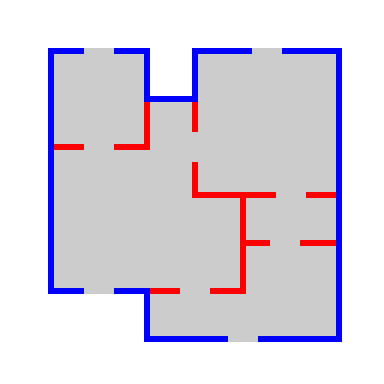
Hell, I don't even remember what it is, some kind of horror:

Making small prototypes was fun, but none of them I pulled out into a full game. At the main job, things were different ... I had to focus on other team members, and any innovation always mixed up the cards to some extent. Working from home and the almost complete lack of live contact with other employees also left an imprint ... when you don't see the team's reaction to your work, it begins to seem that it has no value for anyone at all.
Towards the end of that year, I lost heart and decided to leave the company. It seemed to me that I could easily return to what I was doing before - creating flash games. I now had a good airbag and felt confident about the future. I just had no idea what changes had taken place in the market.
2013: the flash apocalypse as a prequel to the indie apocalypse
Intoxicated by my newfound freedom, the first thing I wanted to do was join the Global Game Jam, which is held every January. Until now, I have not yet participated in jams, but somehow I needed to warm up. In game dev jams, participants are given 48 hours to make a game on a given topic. That year the theme was heartbeat, in the most literal sense. I made a little game and called it Heart the Beat:

The fact that I was able to finish the game in 48 hours gave me even more confidence in my abilities. I was ready to take on something harder!
In terms of technology, Flash has gone through significant development over the past three years. Instead of pulling all the juices out of the processor, it was now able to use graphics card resources thanks to the new Stage3D API. This made me very happy. So the way is open for 3D games!
Of course, I rushed to re-create Homeworld again.

But this did not last long - after three months I stalled. Okay, my spaceships are attacking each other, rockets fly, lasers shoot. But all this, as I now understood, is only a small part of a good game. And the atmosphere? And the story? And what about the player's motives? Ambition grew so much that it fettered me hand and foot. I decided the best thing about this situation was to take the risk and make the game free.
To regain some of my shaken faith in myself, I signed up for another two-day Ludum Dare jam, which is held three times a year. The largest online community has gathered around this jam, so have a lot of fun! Before the start of the jam, participants are asked to choose a topic by voting. I really wanted the theme to be potatoes, but minimalism won out. In retaliation, I made a game where potatoes destroy minimalist figures.

Ludum Dare has an excellent rating system: the more you play and leave reviews on other people's games, the more players and reviews your own gets. This is a very effective way to improve your skills and communicate with other developers. I participated in Ludum Dare twice more that year. Made a dope neon shooter ...

... and a wacky toy where a little ninja chops down other little ninjas.
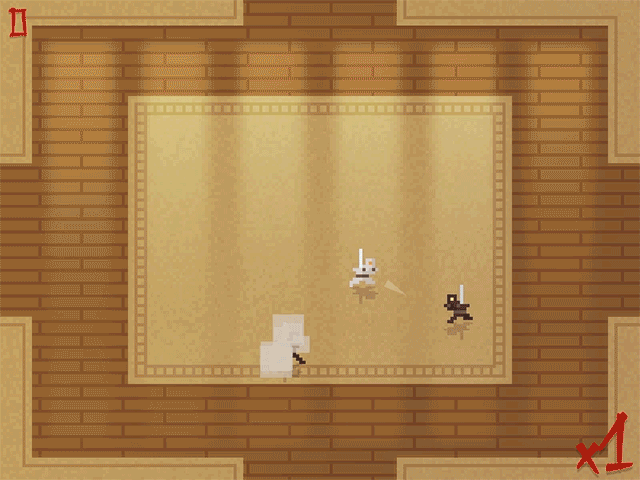
To my great surprise, these two games became the most popular of my works. And they still remain. I'm serious. They have been played by millions of people. They even appeared on Kotaku and Rock Paper Shotgun. But despite this popularity, I made no more than five hundred dollars from them, on sites like Kongregate, which share ad revenues with developers.
I got a little panicked and decided to stay in my comfort zone - 2D strategy, the action takes place in space.

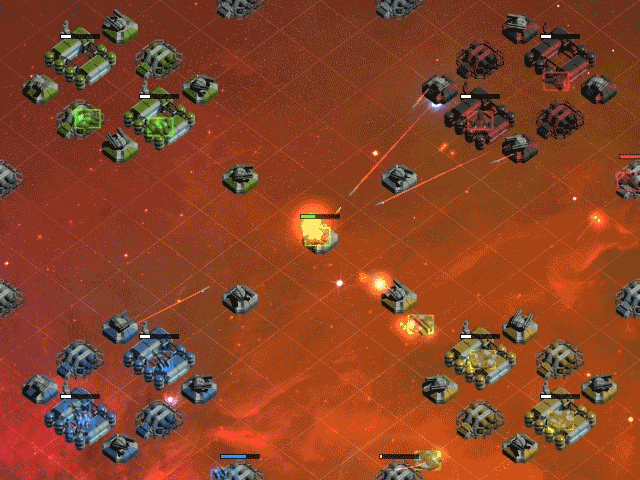
The game was called Spiral Drive (creativity denied me here). I worked feverishly on it for three months. It's kind of a lightweight real-time strategy game. It is necessary to capture stations with the help of spaceships, which automatically produce new ships. The ultimate goal is to capture all objects on the map. Enemies do the same.
Thanks to the new Stage3D Flash API, the game could run at 60fps and run on iPhones and Android phones. I was sure that she would bring good money!
However, a lot has changed there since the last time I visited FGL. Compatibility with mobile platforms was now taken for granted, and Flash games were rated lower by sponsors because they themselves were making less money from advertising. Bidding was slow and sluggish ... Ultimately, the highest bid I was offered was $ 5,000 for the web version, plus the rights to publish the mobile versions. I was disappointed, but it's still better than nothing.
According to the terms of the deal, it was assumed that we would divide the profit from the mobile versions in half, so I hoped that I would get something else from this title. Alas, I do not want to sound vindictive, but the publisher completely screwed up the release on mobile platforms. On the day of release, we were looking for a game and could not find it. It turned out that the publisher had downloaded a game called Sprial Drive instead of Spiral Drive. No, I understand everything, such an error can easily slip through, and it is my own fault that I did not pay more attention to the name, but it all ended with the application going to the bottom somewhere in the markets and almost nothing worked.
It didn't go as planned. It was becoming clear that FGL could no longer be relied on as the main source of income.
2014: transition to mobile games
At the beginning of the year, we welcomed our second child. Lyrical digression: babies smell very good. But having children solely to smell them is not worth it. Borrow better from someone and smell the health, only return later.
The family grew, and I felt a growing responsibility for its maintenance. People were moving to mobile platforms, and the popularity of Flash games declined. It was obvious that developers would also have to go into the mobile sphere.
Over the past few years, I have heard many requests for a sequel to Solarmax. In general, I usually don't make sequels, because during the development process I play the whole game a thousand times and it bores me to death. It's much more interesting to develop a fresh idea. But the savings were gradually melting, and I was already ready for anything.
When working on Solarmax 2, I focused on the simplest, most transparent interface possible. The game should be tailored for a wide variety of screens, from tiny phone displays to full desktop monitors. Terry, who loves this style of games, tested it to the core. I spent five to six months on development.

We didn't want to contact the publishers anymore and decided that we would release the game ourselves. The plan was as follows: publish the game for free on portals with flash games and put links to versions for iOS, Android and desktop - they were paid. We hoped that with the first wave of players from flash portals, the game will break into the top in the iOS and Android app markets, which will further increase sales.
On June 7th, 2014, we released the game with trembling hands ... and got terrible results.
On flash portals, players could rate the game from one to five stars. At the same time, only titles with a rating of 3.5 - 4.0 and higher got to the main page. Getting to the main page was crucial - it depended on whether the game would gather several hundred players or hundreds of thousands. We hoped that traffic from flash portals would provide us with good sales for mobile versions as well.
A few hours after the launch, the game's rating was 2.7 ... I remember how I just lay there and tried not to cry. Then I read the comments. Some users were very annoyed about the difficulty levels and controls. I could fix that. With Terry cheering by my side, I spent hours like crazy adding additional difficulty modes and making changes to the control scheme. When the game was updated, Terry and I tried to write to everyone who left a negative review and asked to play the improved version again.
It had an effect. The rating gradually crept upwards and finally stopped in the range of 3.7 - 3.9. The game hit the main pages of many flash game portals, and a few days later began to appear on the pages with the best new games on the iOS and Android markets.
In the first two months, the title grossed over eleven thousand dollars; the profit was split almost evenly across the two platforms. By the end of the year, he had brought us over twenty thousand dollars.


Apple App Store ~ $ 5500, Google Play store ~ $ 6000
The wisest thing at this stage was to try to repeat the success with another game, releasing it taking into account everything we learned during the first release. I'm sorry I didn't. For me mobile and flash games have always been only an intermediate stage. Deep down, I knew that I would not rest until I learned how to recreate the games of my childhood - those desktop titles that occupied all my time and thoughts.
I signed up for a competition for RPG game developers. Unfortunately, I found out about it late, there were only two weeks before the deadline. I hastily bungled the prototype, borrowing the graphic style from the then popular game Monument Valley:

I didn't manage to meet the deadline, but under the pressure of time pressure, I came up with a new technique for rendering isometric characters. Instead of using sprite sheets, which draw all possible angles, I tied everything on a set of points made in 3D and working as joints and bones of the character, on which the shapes were then superimposed in 2D.
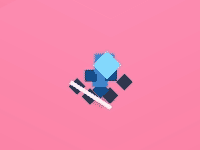
Each joint had X, Y, and Z coordinates. I animated them, and then translated the 3D coordinates to 2D for the screen plane using this formula: This kind of mechanics made the code go crazy. The deadline has passed anyway, so I tried to save everything that could be saved, and figured out a new prototype; This time, the inspiration was Frozen Synapse, a game where you need to destroy the enemy team using tactical thinking and machine guns.
screen_x = x - y;
screen_y = (x + y)*0.5 + z*1.23;
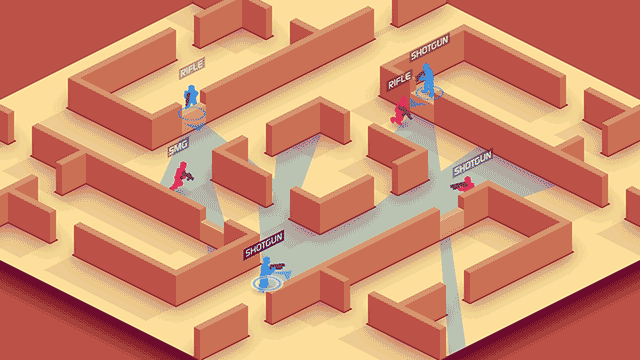
The prototype looked promising and I continued to improve my animation and character rendering techniques:

Unfortunately, I got stuck halfway and didn't finish the project, as happened with Spatial. The game was released in a free version. The problem was that I was good at sketching game mechanics, but I got stumped when it was necessary to think over the content so that it was enough for a full game. All of my prototypes looked like techno demos rather than well thought out things.
But what else remains in this situation, how not to make new and new prototypes? After all, you never know which one will unfold into a finished game. The next number of the program I tried myself in the genre of stealth action. The game was in the style of Tron:


At first glance, it looked amusing, but I could not manage to come up with anything interesting with stealth mechanics. I waved my hand at the stealth element and switched to pure action. In doing so, I relied on one of the most popular games at the time, Hotline Miami.

Now the game has become fun! And the visual part was quite original. It began to seem to me that I was holding something worthwhile. I came up with the name - Lithium City. I was haunted by the feeling that I could finish this game and that it would perform well on the desktop market. I set aside six months for development - so far all projects have taken me about this time. I never imagined that this game would become a central part of my life until the very end of the decade.
2015: honeymoon
I've already mastered the graphics rendering, development and game design in general, but to compete with the stars of the Hotline Miami level, it was necessary to provide the game with a good soundtrack. I showed the game to my younger brother John Camara, an extraordinarily talented composer and audio engineer that no one has heard of yet.
John already wrote the music for Solarmax 2 for me, and the game owes much of its success to him. Many people, after playing the game, went to look for the soundtrack. We got down to business. I worked on additional levels, weapons and enemies, and John on sound effects and music.
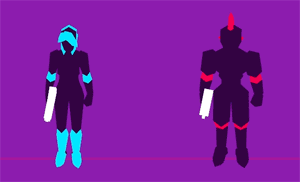

One thing I've had a hard time doing so far is character animation. It was especially difficult to animate the death of enemies: the scenes had to be varied, otherwise it turned out too monotonous. I came to the conclusion that the easiest way is to blow up the characters so that they fly into small pieces.

There were a lot of problems with the implementation of the shooter in isometric view, but we coped with most of them.

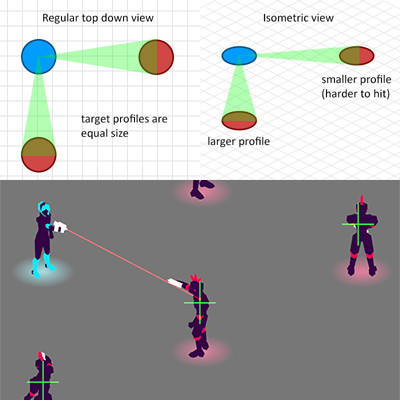
At some point, I was carried away to the wrong place and I decided to radically change the design: from rooms shining with neon light, to realistic lighting and preliminary rendering.

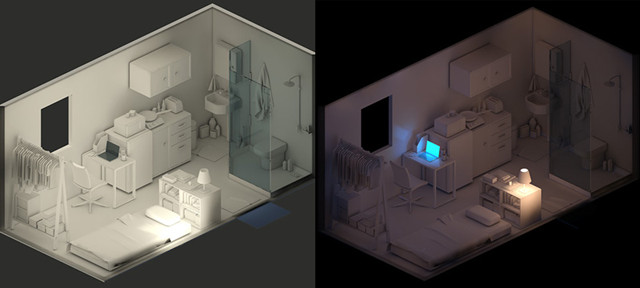
But it took me more than a week to create a single room! I went back to the original version. With simplified styling, levels were made much faster.
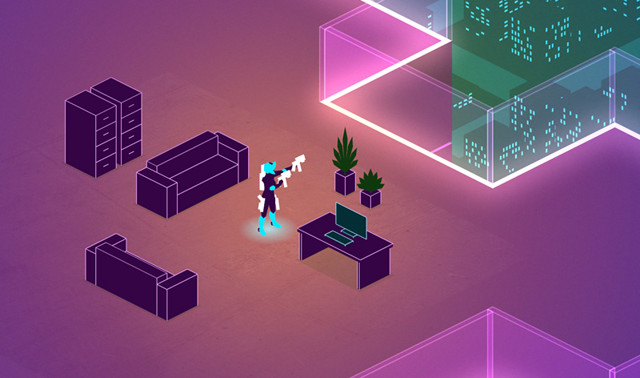
There was another problem with game levels. We didn't have a map editor, so I created the levels using Photoshop in pixel art. A special algorithm then parsed these images pixel by pixel, looking for specific shapes and colors, and based on this, rebuilt walls, furniture, doors and other game objects.
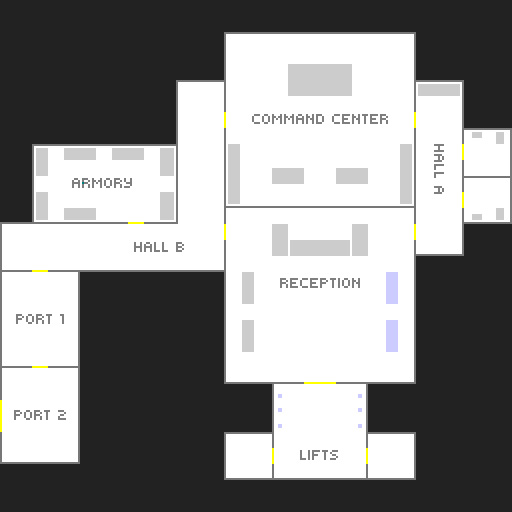
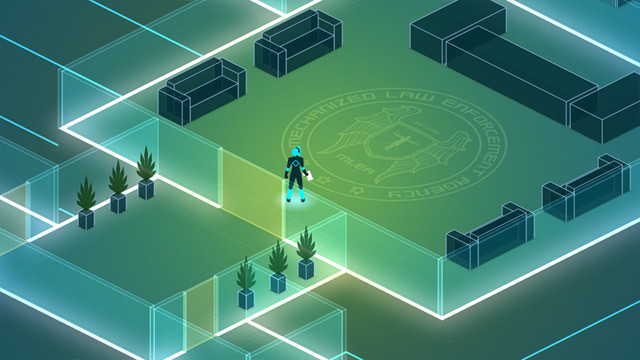
The game gradually took on a finished look. To celebrate, we could not wait to show it to the world. We started to think about how to spread the word about the title. Among other marketing gimmicks, we applied for the GDC festival in China, also called IGF. To our complete delight, we were accepted! The game made it to the final, which means we had to fly to Shanghai and present it at the festival.
It was scary to finally give the title up to the players, but the response was overwhelmingly positive! It was also very useful to observe how people play the game with my own eyes. It is immediately clear which areas need to be improved. And, as the cherry on the cake, John won the music prize! We took away the IGF award for the best audio from the festival. John went up to the stage to accept the award, and burst into tears from excess of feelings. Then I hugged him tightly.
We seemed to be heading in the right direction. It only remained to release the game.
2016: festival fever
Just before Valentine's Day, we had our third child. You are probably already asking yourself how many children we planned to have. Well, what can I say, both Terry and I grew up in large families - five children each. In our opinion, the experience of living together with many brothers and sisters is very Filipino. In addition, there are other advantages: children always have someone to play with, they socialize early and learn to negotiate with each other, birthdays are always celebrated violently and massively. And also ... uh ... economies of scale? With the first child, you have to completely break the usual way of life, but when there are more of them, you can simply use what has already been done. After all, it is more logical to buy a crib and an electric breast pump with the expectation of using them several times? Okay, this is some stupid reason. But watchhow children play and grow together is a special joy.
Coming back to the world of game development, I learned a letter with an offer that took me by surprise. A fairly large company expressed a desire to buy Solarmax from me as intellectual property. In other words, they received ownership of the first and second parts of Solarmax, as well as the right to release sequels in the future and port the game to mobile platforms and desktop. In short, everything accompanying.
This caused mixed feelings in us, and there was no desire to mess around with the transfer of intellectual property, so we named a figure that significantly exceeded the total profit that the game brought during its existence. But after short negotiations, the company agreed to our terms.
I cannot name the exact amount, however, according to my calculations, this money should have been enough for us for two or three years of life and the costs associated with the development of Lithium City. I doubted that I would ever take on new parts of Solarmax, and besides, it seemed to me that the company might do better, that they would figure out how to develop the game in a new direction. It was difficult to refuse.
What do we immediately do when we receive a lot of money? Of course, we send them to game festivals (spoiler: this is a very bad idea)!
The audio reward we received at GDC in China included two full free tickets to the main festival in San Francisco. These two full tickets saved us a lot of money, but we had to pay for travel and accommodation ourselves. But we were full of enthusiasm, and at that time it seemed that the trip was definitely worth it. I also wanted John to go through the experience that I had on my first trip to GDC.
We wanted to create more buzz around the game, so we signed up for several more festivals, including the G-star in Busan, South Korea, the Tokyo Game Show in Chiba, Japan, Casual Connect in Singapore, and the ESGS local festival in Manila. (E-Sports and Gaming Summit) and even a small university event.
Looking back, no matter how exciting it was to drive the game to different gatherings, it definitely cannot be called the best strategy to round out the project. When you realize that the festival is just around the corner, you try to tweak the product so that it looks good during the demonstration - that is, you bring things up to the action as soon as possible, change the mechanics more often to maintain interest in the game ... even if not for long.
As you probably already guessed, travel expenses were multiplying and we were burning money very quickly. At such a pace, there was already talk about two or three years, we could be left with nothing next year. So we gave up on festivals and honestly humped over the game.
Development is far from being as fun as traveling to gatherings, it drags on endlessly and is often boring. And a long-standing problem has surfaced again ... I haven't been able to create enough content to stretch across the entire game. I was too used to grabbing onto projects and then throwing them away, and already had a poor idea of how to make something finished. The matter has reached a dead end.
2017: collapse
The family grew and required more and more expenses. Diapers, milk, groceries, kindergarten fees, doctor's appointments ... the list of needs is endless. The money came out in March. The game wasn’t ready yet.
Until the last moment it seemed to me that as soon as the money began to run out, I would immediately instinctively switch to the increased productivity mode and finish the game - well, as I was finishing my coursework on the last night. It turned out differently. Deadlines passed one by one. An inner critic awakened in me, who insisted that if I released the game in its current form, then all the people we showed it to would be disappointed. After all, we traveled around the world for a whole year, telling everyone what a stunning game we had - now we must not allow it to fall short of stunning.
To buy a little more time, no matter how embarrassing it may be to admit it, I ran to my mom-dad. Yes, yes, at the age of thirty I asked them for money to live on, assuring me that I needed only six months more, and then I would return everything. Terri, having taken up entrepreneurship wisely, also earned money, so we could last for a while. I began to take on more household chores.
Aware of the problem (lack of content), I resorted to procedural generation to fill in the voids.

During this period, the graphics in the game have improved significantly. Terry, who was just taking a course in interior design, gave me advice on how to draw furniture and fill the level space. For different levels, I used different algorithms:

If you've ever played a title that uses procedural generation, then you already know where the catch is. This is not a magic wand: on a superficial glance, the levels seem varied, but, in essence, the user experience does not change. Procedural generation made the game not expanded, but simply boring.
I ditched the procedural generation prototypes and started tinkering with the levels again. This time, I decided the right approach was to add a storyline to the game, with characters and dialogue.
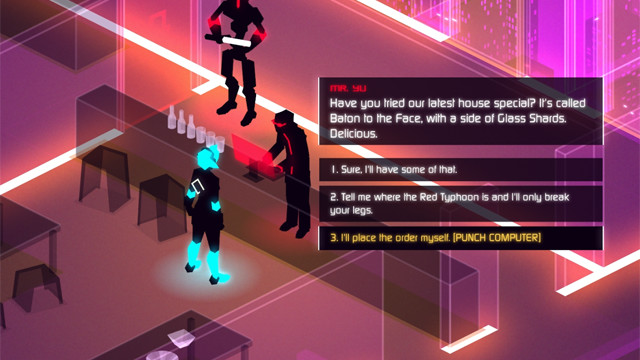
It turned out that the writer of me is so-so. If I could write a couple of lines, the next day I could not read them without shame and quickly deleted them.
All these failed attempts accumulated fatigue. Each time I tried a new method and faced failure, it became more difficult to muster the strength to search for new ideas. Instead of working, I started doing things that made me feel like I was doing something useful even though I was not working. Well, for example:
- Watching videos about design and analytics on Youtube
- Reading marketing articles on Gamasutra and gamedev.net
- Buying all successful indie games and then trying to figure out how they did it
- Replaying game classics in hopes of gaining new ideas for mechanics
- Reading books about writing that should make me a writer overnight
- View posts and screenshots from other developers working on games
- 250 hour RPG walkthrough to "switch" and reawaken your love of games
- Work on a new project, which "can be completed and launched in a month to bring money"
- Reading stories from other game dev representatives on Reddit
I promised my parents that six months will be enough for me to finish the game and settle with them. Not enough. Our fourth child was born in October.
2018: black stripe
When they say “black stripe” a small area is presented to the imagination, which you just need to overcome, and then you will enter the light strip. Nothing like this. Rather, it would be worth talking about the black labyrinth. There is no way out, it is not clear how long we still have to wander, running into dead ends, and there is no guarantee that we will be able to get out at all.
Despite the fact that all the deadlines passed, the parents continued to send us money for our daily needs. I felt like a finished person. It seemed to me that everything that I had achieved before did not matter at all, since I got to the point of sitting on the neck of my parents and wife. Nevertheless, no matter how lousy it is on the soul, this does not exempt from the duties of a husband and father. My career in game development was falling apart before our eyes, but my life was full of happy moments with my family. I don't know how I would have survived this period without them.
The children were growing up. The eldest went to primary school, and in our country, lessons begin at half past seven. Morning idleness was replaced by a rigid sequence of actions: take a shower, make breakfast, prepare food for the children with you, take them to schools.
Any attempt to take up the game ended with the fact that I lost heart and did not have enough strength for anything. The feeling of inaction was unbearable and I felt compelled to give my best in other areas. I started baking. In contrast to development, this hobby cheered me up a lot: you do everything strictly according to the recipe, follow every little thing, iterate - and the reward for your efforts is guaranteed: something tasty that can please others.


First iteration and the result of three months of development
Sorry, I understand that this is an article about gamedev, but I just need to pour out my heart.
We also baked and decorated cakes for children for the holidays. Terri is really keen on sculpting marshmallow fudge jewelry. I was vaguely aware that I was hiding from my problems, but I could not find the strength to face them face to face. During that period, I almost did not turn on the computer, except to look at a recipe or a tutorial for baking.
2019: pay by bills
At the beginning of February, our fifth child was born. A few days later, her cut umbilical cord became inflamed. The temperature rose, the doctor was worried that sepsis might develop. She had to be admitted to the neonatal intensive care unit. Terry and I stayed with her all the time, took turns holding her in our arms and consoled her when a rather large (for her little body) dropper needle caused inconvenience. Required antibiotic treatment and constant monitoring. According to the custom of newborns, she sometimes started waving her arms, the needle popped out, and had to be inserted again, causing pain. We spent ten days in the intensive care unit.
We didn't have enough money to pay the hospital bills. I again turned to my parents for help. They paid. I dropped the problem on their shoulders because I was unable to manage money responsibly while I had it. I was disgusted with myself, I believed that I was only drawing money from my relatives. This could not go on further.
I began frantically looking for vacancies on the net, but it was 2019 and no one was interested in Flash developers. The local game development industry relied on outsourcing business processes, low salaries were offered to beginners, and there were few opportunities for growth. All in all, a waste of time. I opened files from the Lithium City project that I hadn't touched in months. The person I was before failed to finish the game. I had to change.
I started setting my alarm at 5:30 in the morning so that I had enough time to shower, dress as if I were going to work, prepare breakfast and food for the children to take with them. At six in the morning everyone who needed to go to school had breakfast, and at fifteen to seven it was time to leave. Not far from the house there was a coffee shop that opened at half past seven. There I worked until at least noon, sometimes until two. There was no waifai in the coffee shop, and that was completely fine with me - I didn't want to be distracted.
Unlike working from home, you have to pay to work in a coffee shop. But the level of performance is completely different. At home, I walked around and idle, I dressed there as in the office, felt like a professional and this was reflected in my work. I always ordered hot tea without milk and sugar, which cost me one hundred twenty pesos (two and a half dollars).
When I got home, I left my laptop in my bag and pulled iron until the evening, cooked dinner or baked something for the children. I read about how to eat in order to conserve energy throughout the day and work harder. It turned out that sugar is enemy number one, and I tried to completely abandon it. I ate breakfast with oatmeal, a couple of eggs and black coffee. For lunch, most often I ate sweet potatoes, another egg and fruit. In dinner I tried to include as much protein as possible - chicken, pork, beans - and more vegetables. I ate cereals only unpeeled, like brown rice or whole grain bread. That year I lost about seven kilograms.
Most importantly, I ditched Youtube and Reddit until I finished the game - these are the sites that were taking the most of my time. I decided that I had already given them many years of my life and, in any case, I am not losing anything, because they will not go anywhere even years later. I stopped playing games too. You had to think only and exclusively about your own.
All these changes in lifestyle, little by little, gave results. After setting a fixed time frame for myself in the morning, I found myself really starting to serve content. I began to tell myself that it is better to do at least something than nothing at all, then there will still be an opportunity to make changes if I come up with something more successful.
The new content was darker ... perhaps it reflected my state of mind.
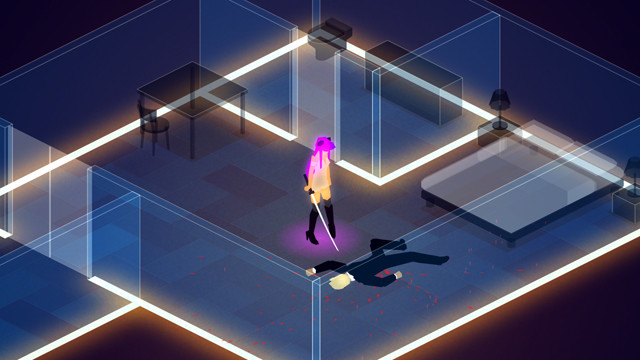
However, my technique worked. I have systematically expanded the content.
In my struggle with the main problem, I chose the tactics of guerrilla warfare: hit and run. If you are faced with something too difficult, get away with it and choose another object to attack. Do not stop and do not stay in one place for a long time. If you get bogged down, defeat is inevitable.

You have to pay for everything. My categorical attitude to work began to seep into relationships with my family. In our seven years of marriage, Terry and I barely fought in earnest, but now fights have begun. Swearing with my mate is unpleasant, but I kept repeating to myself that the game would not haunt me all my life. Every day I came closer and closer to defeating this monster.
I gave up trying to plan everything and just did what naturally flowed from what I had done the previous day. There was nothing sacred left: if something did not work, I swept aside this option and started over.
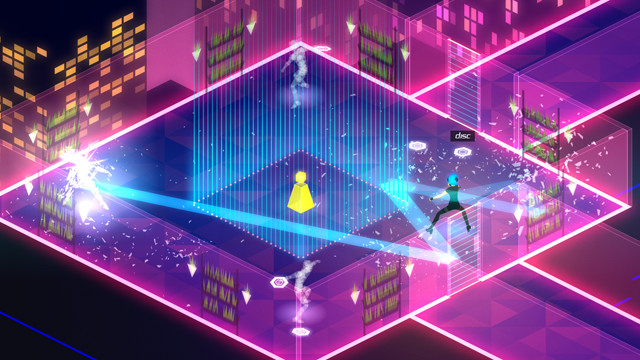
With this approach, I finished the prologue and six chapters by the end of the year. The game was supposed to have thirteen chapters by the time it was completed, but life decided otherwise.
2020: here comes the apocalypse
On January 12, a volcano erupted twenty-five kilometers from where we live. He vomited out a pillar of ash 1.5 kilometers high, which covered all nearby cities, not excluding ours.
Fortunately, the walls and roof of our house were strong, so that he did not threaten to collapse under the weight of ash, like many others standing near the volcano. But it was impossible to hide from the ashes itself. It turned out to be abrasive. The slightest breeze tossed him into the air, he penetrated into the house through windows and doors. When wet, it became heavy and conducts electricity well. Every time it rained, power lines were shorted and electricity was lost.
But the ash posed the greatest danger to the lungs. There are asthmatics among our children, and the mask cannot completely protect against inhalation of the smallest particles. We held out for several days, but in the end we had to evacuate. We drove north to Manila, the capital city where my parents had accommodated us. I took my laptop with me, but in the thick of things and the confusion created by the changes in my life, I did not make any progress at all.
We are very lucky. Many families have suffered much more. We managed to return in a little over a week. The ashes did not disappear completely, but there were fewer of them, and he no longer threatened to cause an asthma attack in any of the children. Many schools and other institutions were still closed, so we spent most of our time at home. I tried my best to stay productive, but started checking Youtube and Reddit again.
On March 16, before I could make any significant progress, the government announced a quarantine in the country. The hopes that we would soon return to normal life were dashed.
In April, my father called me and bluntly said that they were going through hard times, and I was only aggravating the situation. My parents no longer had the opportunity to support me financially. I was unable to finish the game - out of thirteen chapters, only six were ready.
One of the lessons I learned from my years of productive work was this: "Use everything that is, and don't expect too much." I only had half of the game that I wanted to create in my hands ... but still, it was drawn to the game, and I spent almost six years of my life on it. It had content for two to three hours of play. The most skilled players would probably have completed it in an hour and a half. It was really possible to release such a thing. I made changes to the sixth chapter and the prologue to tie everything together and create a sense of completeness, a short story. I reduced the price - eight dollars instead of fifteen or twenty, as I thought before.
Steam has announced that the Summer Game Festival will take place from June 9th to 14th. We decided to participate, believing that the festival will help us to arouse interest in the game in the audience and get into wishlists. We have planned the release for the fifteenth of June - the day after the end of the festival.
April and May passed in desperate attempts to eliminate all bugs and get the game ready for release. Some problems only come up when you sit down and play the game from start to finish. It takes a lot of time to fix them, because you have to repeat the process several times to make sure that everything is in order now.
John, who did not give up work on audio tracks for the game and showed great patience during my unproductive period, took up the recording and editing and made for the gameHere is such a cool trailer .
On June 1st, we sent out a trailer, letters and press releases to YouTubers and local and foreign resource management for gamers. On June 6, three days before the start of the festival, Steam announced the postponement of the event, which was now supposed to take place from June 16 to 22 - that is, after our release. We have already publicly announced the release date for the game. It was impossible to change it at the last moment.
I wrote a letter in support of Steam asking if we can still participate in the festival - when submitting an application, it was emphasized in the form that it was designed only for games that had not yet been released at the time of the event. The answer came as follows:
, !
, . Steam Game Festival – , , , .
. , . , , .
.
Well, at least they didn't say in plain text that they would exclude the game unless we change the release date. For a while I thought: maybe we should release the game of the fifteenth as planned, and do nothing about the festival? Knowing Steam, everything is automated there. Ultimately, I decided that it was better not to risk conflicts with the portal on which I rely, if everything goes well, to feed myself, and asked to exclude the game from the festival.
The game was released on the fifteenth of June, the number of wishlists did not reach three hundred. Today is the twenty-fourth of June, a week has passed and we have sold two hundred copies.
As far as I know, all marketing articles say in unison that you need to collect as many wishlists as possible before release and that the main sales come in the first week. So we screwed up.
But this is not the first release disaster, after which we managed to get back on our feet. When this kind of trouble comes, the only thing that remains is to solve the problems as they come. When we released Solarmax 2, we were let down by the complexity and control. This time I'm sure the game is of high quality. We received twenty reviews from two hundred sales with an overall rating of 95%. So far, only twenty-three thousand people have visited the game page. The problem is that we didn't go out to the public. I am convinced that this can be fixed.
Of course, I know that even a good game is not always financially successful. But I also know something else: if I stop fighting for the audience now, it will be a real failure. And I don't know anything else. It feels like after ten years in game development I'm starting from scratch again.
Finally
When I sat down to read this article, I thought that a day would be enough for me. One week and seven thousand words later, I present to you the final result. As it turns out, I still haven't learned how to estimate how long the work will take. Squeezing the last ten years of my life into a readable article for the Internet has been harder and more emotionally exhausting than I imagined.
I am still eager to make games. Apart from my family, this activity brings me the most joy. Games have always given me the feeling that I can become something more and cope with any difficulties if I put in enough time, skill and perseverance. In the last couple of years I've had a very difficult time, but I doubt I'll ever give up my intention to make games.
If you have read the entire article to the end, I am sincerely grateful to you. Thank you for giving me the opportunity to share this story with you.
Nothing fancy there, but I've packed all the short games and prototypes I've worked on in a zip file that you can download. Basically there are SWF files, which you need Standalone Flash Player to view. Adobe will end support for Flash Player on December 31st of this year, but you can download the correct version here. Scroll down to the list of files available for download and click on Download the Flash Player projector.
Download Niko's Flash Games (requires Flash Player Projector) - 53 MB
Download Niko's Desktop Games (Windows only) - 127 MB
Visit the Lithium City Steam page
Original article (more photos and egg tarts recipe)
Thanks again and see you in ten years!